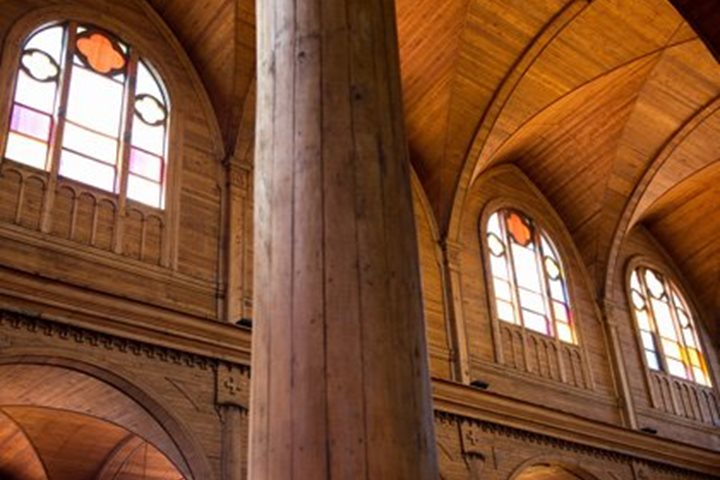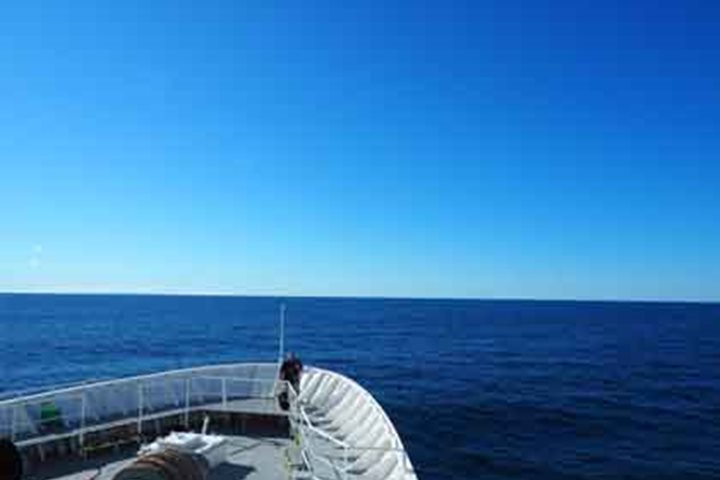The first light of dawn finds us docking at the quiet port of Saleverry near the town of Trujillo. The sky is gray, not a stormy gray, but a marine-layer gray, sort of a high fog so common in this part of the world. I find this very pleasant, as coastal Peru is absolute desert where annual rainfall is measured in tenths-of-an-inch, if even that and natural vegetation is very scarce. Nonetheless, with the marine-layer it is cool and not too bright nor arid.
We need an early start as there is a lot to see. Just after breakfast we board three, surprisingly nice double decker buses. ‘Surprisingly’ because where we are does not look too modern. As we drive southward, avoiding the city of Trujillo we observe that while we might be in absolute desert there are plenty of green growing things, both ornamental plants and crops. There are irrigation canals everywhere, a tradition started by the Moche people more than 2000 years ago! Yes, it does not rain very much at all on the coast, but there is a great deal of precipitation on the not so distance Andean slopes that flows towards the coast.
Our first stop is at the coastal resort town of Huanchaco, famous for its dramatic surf and its small reed fishing boat that can navigate the waves. The boats are made of a bulrush (totora reed), locally grown. They are about 15 feet long with a graceful upswept bows that keeps the boat above the waves. These are one-person boats in which the fisherman either kneels or sits. We watch a demonstration of driving the reed boats through the surf. Fishing this way is now only practiced by a few, mostly older men. Not enough fish can be caught and the totora reed that grows in hand-dug pits along the coast is becoming scarcer due to beach erosion. Many of the younger folks have become surf instructors or found jobs working in modern fisheries. But still, the reed boats are both beautiful and graceful.
From here, we make the short drive to the amazing ruin of Chan Chan. In the 15th century this was the site of the largest city in the Americans and the largest adobe city in the world. It has been estimated that 40-60,000 people lived here, the capital city of the Chimu’ whose empire stretched from central Peru to Ecuador. Among the empire’s elite it was definitely believed that all people were not created equal! “The Sun peopled the world with three eggs: a golden egg for rulers and high nobility, a silver egg for their wives, and a copper egg for everyone else.” There were plenty of these metals around as well. Many of the people living at Chan Chan were artisans brought together willingly or not, to produce beautiful objects. To support a city of this size in absolute desert a series of large canals and irrigation ditches were created. The empire lasted from about 850 AD to 1470 AD when the Inca conquered them. Today there is a new battle to save the ruins from the more frequent El Nino rains. What we explored was a huge, mostly reconstructed palace that originally had 30-foot high ‘mud’ walls with both public and private spaces for the ruling elite.
Looping back to the north we make a final stop at the site of an even older culture, the Moche people who constructed the Temple of the Sun and the Moon at the Moche Valley. Plundering Conquistadores devastated the Temple of the Sun; fortunately, the Temple of the Moon was not as seriously injured. This temple is being actively investigated and conserved and we heard some fascinating stories including those with rituals of human sacrifice to appease the various forces of nature.
We return to National Geographic Explorer in the early afternoon for packing and to make preparations for the Captain’s Farewell. Yup, this is it, our last full day and yet another good day to be remembered.







